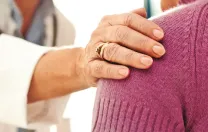When Susan Block, a professor of psychiatry and medicine, started practicing medicine more than three decades ago, there was no formal field of palliative care. Today, it is an established specialty with a growing presence in the U.S. healthcare system. The number of hospital-based programs nearly tripled between 2000 and 2010, and most large hospitals now have palliative-care teams, according to the Center to Advance Palliative Care, a national organization aimed at expanding these services. Still, Americans living in certain geographic regions (for example, where small hospitals are the norm) have limited access to this comfort-centered approach to serious illness.
Palliative care emerged with the hospice movement of the 1960s, but it wasn’t until 2006, after a strategic campaign led by Block and other advocates, that hospice and palliative medicine became a defined medical specialty. The move marked “a critical step in achieving legitimacy and a seat at the table in American medicine,” says Block, chair of the psychosocial oncology and palliative care department at Dana-Farber Cancer Institute and Brigham and Women’s Hospital. “It has raised the stature of the field.”
The specialty now attracts clinicians from many disciplines (one can be a radiologist who goes into palliative care, for instance) and offers trainees another career option, “so it’s had a huge impact on our ability to recruit spectacular young people,” Block adds. There are now nearly 100 hospice and palliative-medicine fellowship programs around the country; Harvard’s fellowships in palliative care educate about a dozen doctors, nurse practitioners, and social workers annually.
Palliative care is associated with higher quality of life and lower costs through fewer and shorter hospital stays, less intensive treatments, and more hospice use, so it’s an attractive option in the context of healthcare reform. But experts worry about the future. There’s already a serious national shortage of hospice and palliative-medicine physicians (one study estimates a gap of at least 6,000), and demand will likely grow as baby boomers age, the number of Americans with chronic conditions (such as heart disease, diabetes, cancer, and dementia) soars, and more providers in community settings, like outpatient clinics, aim to offer palliative care as well. The global demand is rising, too; according to the World Health Organization and Worldwide Palliative Care Alliance, only one in 10 people who need these specialized services receives them—and most palliative care is provided in high-income countries.
Addressing the U.S. shortage will require raising awareness and developing palliative-care skills among professionals and medical and nursing students, observers say. Among the strategies are:
• Training leaders through programs like Harvard Medical School’s Center for Palliative Care, co-founded by Block and J. Andrew Billings about 15 years ago to expand palliative-care education nationally and internationally.
• Ensuring that every clinician who sees seriously ill patients learns basic palliative-care skills, such as effective doctor-patient communication and pain management, while referring the more complex cases to specialists.
• Reminding physicians that palliative care aims to ease symptoms and suffering throughout a serious illness, not just at life’s end, and complements the care patients are already receiving. It’s not about dashing hopes.
Medical schools have traditionally given short shrift to palliative and end-of-life issues, but students today have more exposure than in the past, according to the Institute of Medicine. Virtually all teaching hospitals affiliated with medical schools now have palliative-care teams, notes physician Diane Meier, director of the Center to Advance Palliative Care, and data show that younger doctors are more familiar and comfortable with palliative care.
Areej El-Jawahri, an oncologist on the bone marrow transplant unit at Massachusetts General Hospital, agrees. “I think the culture is changing. We’re the generation who has been exposed to palliative care; it’s a consult service in the hospital that we call for. That is very different than medicine was 10 years ago.” Now an instructor in medicine,she is studying whether addingpalliative-care services will make the transplant experience less physically and emotionally burdensome for patients and families, and hoping as well to “demystify” the approach for her colleagues.
At Harvard Medical School today, there is no required clinical training in the specialty itself, but palliative and end-of-life care principles are woven into various required and elective courses. These include sessions in which students interview gravely ill patients or evaluate their own ability to break bad news to a simulated patient, and a clinical elective on how to diagnose and treat different types of pain.
Looking to “raise the bar” in medical education on palliative care nationally, an HMS team co-led by instructor in medicine Kristen Schaefer recently defined 18 “essential” palliative-care competencies they believe medical students and internal and family-medicine residents should acquire—with communication and pain management skills topping the list. (That list reflects the results of a national survey they conducted among palliative-care educators.) In a paper published in Academic Medicine last July, Schaefer and her co-authors argue that providing this kind of basic palliative-care training is critical to delivering high-quality, cost-effective care to the growing ranks of sick and aging Americans.
Schaefer co-directs an elective on psychosocial oncology and palliative medicine at HMS and says the course’s faculty members value the opportunity to support students “as they grapple with issues of suffering and mortality in ways they often have not before. We remind them that there is so much we can do as doctors to comfort patients, alleviate suffering, and guide patients and families through serious illness and the dying process.”










